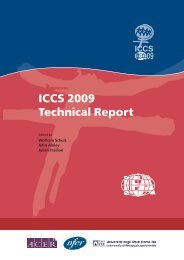Teacher Education and Development Study in Mathematics - IEA
Teacher Education and Development Study in Mathematics - IEA
Teacher Education and Development Study in Mathematics - IEA
You also want an ePaper? Increase the reach of your titles
YUMPU automatically turns print PDFs into web optimized ePapers that Google loves.
112<br />
TEACHER PAY AND STUDENT MATHEMATICS ACHIEVEMENT<br />
developed, <strong>and</strong> by the relative drop <strong>in</strong> teachers’ economic status. The government has<br />
consequently put forward measures to <strong>in</strong>crease teacher salaries <strong>and</strong> welfare benefits,<br />
establish a better promotion <strong>and</strong> evaluation system, <strong>and</strong> improve work<strong>in</strong>g conditions<br />
by reduc<strong>in</strong>g class sizes.<br />
<strong>Teacher</strong> education <strong>and</strong> certification<br />
South Korea’s elementary school teachers are tra<strong>in</strong>ed <strong>in</strong> national universities of<br />
education <strong>and</strong> departments of elementary education at colleges of education. They can<br />
also take elementary education courses <strong>in</strong> graduate schools. Most elementary school<br />
teachers receive their pre-service education at the 11 teachers colleges that make up<br />
the National University of <strong>Education</strong>. Pre-service education for secondary school<br />
teachers occurs ma<strong>in</strong>ly through four different channels: departments of education,<br />
colleges of education, graduate schools of education, <strong>and</strong> teacher education courses <strong>in</strong><br />
comprehensive universities. Potential c<strong>and</strong>idates for both levels of education can also<br />
qualify by tak<strong>in</strong>g re-education or compensational education courses.<br />
To obta<strong>in</strong> an actual teach<strong>in</strong>g certificate, c<strong>and</strong>idates must earn credits <strong>in</strong> both teacher<br />
education <strong>and</strong> major subject courses <strong>in</strong> one of the aforementioned education programs,<br />
<strong>and</strong> subsequently obta<strong>in</strong> formal authorization. For example, secondary school teachers<br />
must take around 140 credit hours over four years, <strong>and</strong> they must complete at least<br />
42 credits from a major subject <strong>and</strong> 20 credits <strong>in</strong> teacher education courses. Students<br />
tak<strong>in</strong>g education courses <strong>in</strong> comprehensive universities must additionally score 80<br />
po<strong>in</strong>ts or higher <strong>in</strong> both subject areas. Students who fulfill these requirements earn<br />
automatic authorization <strong>and</strong> a Grade 2 teacher certificate. If employed as a teacher, they<br />
can subsequently work for another three years <strong>and</strong> participate <strong>in</strong> <strong>in</strong>-service education<br />
so as to acquire a Grade 1 teacher certificate—a qualification that provides a significant<br />
step up the salary scale.<br />
Elementary school teachers who want to teach mathematics must take at least 21<br />
credit hours of subject-based <strong>and</strong> pedagogical courses related to mathematics <strong>in</strong> order<br />
to earn a certificate. Their subject courses can <strong>in</strong>clude classes on calculus, probability<br />
<strong>and</strong> statistics, algebra, geometry, <strong>and</strong> l<strong>in</strong>ear algebra. Their pedagogical courses tend<br />
to cover areas such as teach<strong>in</strong>g methods <strong>and</strong> the theory, assessment, <strong>and</strong> psychology<br />
of mathematics education. The secondary school teacher mathematics curriculum<br />
emphasizes subject matter to a much greater extent than does the elementary school<br />
teacher mathematics curriculum. Seoul National University, for example, requires<br />
students to take 18 mathematics knowledge courses <strong>and</strong> five pedagogy knowledge<br />
subjects. The course requirements for secondary school mathematics teachers are thus<br />
essentially the same as for majors <strong>in</strong> regular departments of mathematics.<br />
After acquir<strong>in</strong>g the teach<strong>in</strong>g certificate, teachers must also pass a national employment<br />
exam<strong>in</strong>ation <strong>in</strong> order to be assigned a teach<strong>in</strong>g job. The first part of the exam<strong>in</strong>ation is<br />
a written test, 30 po<strong>in</strong>ts of which derive from education-related questions <strong>and</strong> 70 po<strong>in</strong>ts<br />
of which derive from major subject questions. This first part whittles down the number<br />
of applicants to equal 120% of the employment spots. The rema<strong>in</strong><strong>in</strong>g c<strong>and</strong>idates are<br />
then screened via the second exam<strong>in</strong>ation component, which comprises essay writ<strong>in</strong>g<br />
<strong>and</strong> a short <strong>in</strong>terview.<br />
The test for mathematics teachers is particularly comprehensive <strong>and</strong> covers 10 major<br />
areas of college mathematics <strong>and</strong> mathematics education, as well as general education<br />
theory. Because only about 16% of secondary school mathematics teacher c<strong>and</strong>idates

















